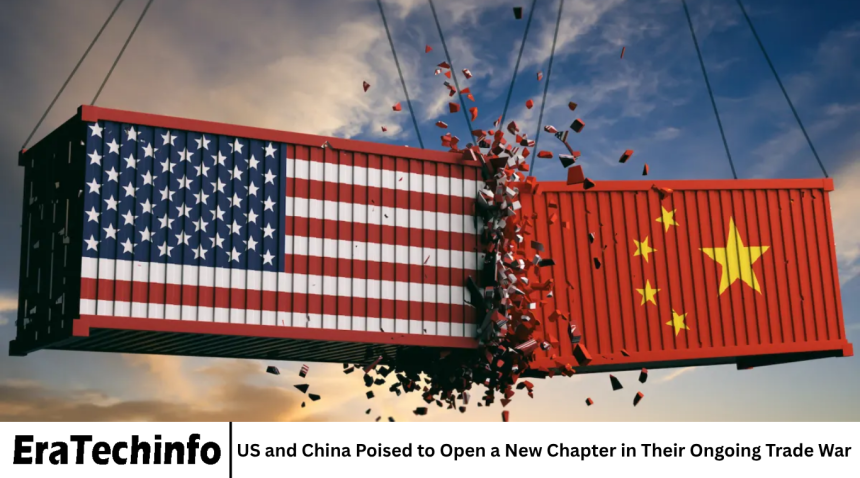The United States and China, the world’s two largest economies, are once again facing rising tensions that could open a new front in their long-standing trade war. What began years ago as a dispute over tariffs and intellectual property has evolved into a broader struggle for economic and technological dominance.
Recent developments suggest that both countries are preparing for renewed confrontation. This time, the focus is shifting from traditional goods like steel and agriculture to advanced technologies such as artificial intelligence, semiconductors, and renewable energy components. The growing rivalry is reshaping global supply chains, investment strategies, and alliances.
This article explores the roots of the US-China trade conflict, the new areas of dispute emerging in 2025, and the potential consequences for businesses, workers, and consumers around the world.
The Origins of the US-China Trade War
The trade war between the United States and China officially began in 2018, when the US government imposed tariffs on Chinese goods, accusing China of unfair trade practices, currency manipulation, and intellectual property theft.
China responded with retaliatory tariffs on American exports, leading to a cycle of economic escalation that affected billions of dollars in goods. The conflict disrupted global trade and created uncertainty for industries dependent on cross-border supply chains.
Although both countries reached a partial “Phase One” trade deal in early 2020, underlying tensions remained unresolved. Issues such as technology transfer, market access, and state subsidies continued to strain the relationship.
Over the years, the trade dispute has transformed into something far more complex—a strategic rivalry that extends into technology, national security, and global influence.
The Shift Toward Technology and Security
In the early years of the trade war, tariffs and agricultural restrictions dominated the headlines. But in recent years, both the US and China have shifted focus toward technology—a sector seen as key to future economic and military power.
The United States has restricted exports of advanced semiconductors, AI chips, and related technologies to Chinese companies, citing national security concerns. Washington has also pressured its allies to reduce dependence on Chinese tech firms, particularly in areas like telecommunications and energy infrastructure.
China, meanwhile, has accelerated efforts to achieve self-sufficiency in technology. Under its “Made in China 2025” strategy and new innovation plans, it is investing heavily in semiconductor production, robotics, and renewable energy systems. The goal is clear: to reduce reliance on foreign technologies and strengthen its position as a global tech leader.
This new front in the trade war is not just about economics—it’s about control over the future of innovation.
The Semiconductor Battle
Semiconductors, or microchips, have become the centerpiece of the new trade war. These tiny components power everything from smartphones to fighter jets, and whoever dominates chip production holds immense global influence.
The United States has imposed strict export controls to prevent China from accessing cutting-edge chipmaking equipment. It has also pressured companies like Taiwan’s TSMC and South Korea’s Samsung to comply with these restrictions.
China has responded by pouring billions into its domestic chip industry, building new factories and investing in research. However, despite its progress, it still relies on Western technology for advanced chip production.
This battle has major implications for industries worldwide, as chip shortages and production limits affect manufacturing, consumer electronics, and automotive sectors.
Trade Tensions Expand to Green Energy
Another emerging area of confrontation is green technology. As both nations aim to lead the global transition to renewable energy, competition has intensified over solar panels, electric vehicles (EVs), and battery production.
The US accuses China of flooding the market with low-cost solar components and EV batteries, undercutting American manufacturers. Washington has introduced tariffs and subsidies to protect its growing clean energy sector.
China, on the other hand, argues that it is simply leading the way in producing affordable renewable technologies for global use. It continues to dominate global supply chains for critical materials such as lithium and rare earth elements, which are essential for green technology production.
This rivalry is shaping the future of the global energy economy—determining who will lead the next industrial revolution.
Rare Earths: A Strategic Weapon
Rare earth elements are crucial for producing electronics, electric vehicles, and defense technologies. China currently controls around 70% of global production, giving it significant leverage.
In recent months, China has tightened export restrictions on certain rare earth materials, citing environmental and national interests. However, many analysts believe this move is a strategic response to US technology sanctions.
The United States views this as a potential threat to its industries and military readiness. In response, it is exploring ways to diversify supply chains, reopen domestic mines, and form partnerships with countries like Australia and Canada to secure critical minerals.
The rare earth battle is becoming one of the most sensitive fronts in the new trade confrontation, as it ties directly into both national security and the green economy.
The Global Ripple Effect
The renewed US-China tensions are not confined to these two nations—they have global consequences. As tariffs rise and export controls tighten, other countries are caught in the middle.
Manufacturers in Europe, Asia, and Latin America are being forced to rethink supply chains and sourcing strategies. Many are shifting production to Southeast Asian countries such as Vietnam, Thailand, and Malaysia to avoid tariffs and political risks.
Global investors are also watching closely. Market uncertainty affects stock prices, currency values, and commodity costs. Multinational companies that depend on both US and Chinese markets face difficult choices about where to invest, manufacture, and sell.
For consumers, the impact may come in the form of higher prices for electronics, vehicles, and household goods. The longer the conflict lasts, the greater the disruption to global trade stability.
The Role of Politics and Elections
Trade policy in both countries is heavily influenced by domestic politics. In the United States, trade relations with China have become a central topic in election debates. Political leaders across party lines often view China as both a competitor and a strategic threat.
In China, the government portrays US sanctions as attempts to suppress its rise as a global power. This narrative reinforces national unity and support for Beijing’s self-reliance strategies.
As both governments respond to public sentiment, compromise becomes harder to achieve. Each side faces pressure to appear strong, making it difficult to de-escalate tensions even when economic costs mount.
The Digital Economy and Data Wars
Beyond physical goods, the next phase of the trade conflict is expanding into the digital realm. The US and China are competing to set global standards for emerging technologies like artificial intelligence, 5G networks, and data governance.
The United States has restricted Chinese tech companies such as Huawei and TikTok over concerns about data privacy and national security. It has also promoted alliances with other democratic nations to establish “trustworthy” digital infrastructure.
China, in turn, is promoting its own model of digital governance through initiatives like the Digital Silk Road, part of its broader Belt and Road strategy. This push aims to expand China’s technological influence in developing countries.
The competition to control data, software, and digital networks could define the next decade of the trade war—one focused less on tariffs and more on information power.
Impact on Global Supply Chains
The reshaping of supply chains has been one of the most significant outcomes of the trade war. Companies are increasingly adopting a “China plus one” strategy, diversifying their manufacturing bases to reduce dependency on any single country.
This has led to new investments in countries such as India, Vietnam, and Mexico. While this shift creates opportunities for emerging economies, it also increases production costs and complicates logistics.
Supply chain resilience has become a global priority. Both the US and China are encouraging domestic manufacturing through subsidies and tax incentives. The result is a gradual but steady decoupling of their economies, with long-term consequences for globalization.
The Currency and Financial Front
Another dimension of the trade war involves finance and currency policy. The US has accused China in the past of manipulating its currency to gain export advantages. While such accusations have faded in recent years, currency fluctuations still play a key role in trade competitiveness.
Financial restrictions are also emerging as a new battleground. The United States has imposed investment bans on certain Chinese companies, while China has tightened control over foreign financial access to its domestic markets.
The US dollar’s dominance in global finance gives Washington significant leverage, but China is increasingly promoting its own digital currency as an alternative for international trade settlements.
Efforts to Ease Tensions
Despite the mounting rivalry, both nations recognize the importance of maintaining some level of cooperation. Periodic talks between trade representatives aim to stabilize markets and prevent further escalation.
In areas like climate change, global health, and food security, the US and China share overlapping interests that require dialogue. However, mutual mistrust continues to limit progress.
While a full resolution seems unlikely in the near term, small agreements—such as easing certain tariffs or expanding agricultural trade—could help rebuild communication and prevent a complete breakdown in relations.
What This Means for the World Economy
The renewed trade tensions come at a time when the global economy is still recovering from inflation, geopolitical conflicts, and supply chain disruptions. Any escalation between the US and China could slow global growth and increase market volatility.
Countries that depend on trade with both powers will face tough choices. Exporters may need to adjust to shifting demand, while importers could struggle with rising costs and supply uncertainty.
Financial markets are also sensitive to policy announcements from either side. A single statement or sanction can trigger sharp reactions in global stock exchanges and commodity prices.
In the long term, the trade war could lead to the emergence of two competing economic blocs—one centered around the United States and its allies, and the other around China and its trading partners.
The Future of US-China Relations
The next phase of the US-China trade war is likely to be defined by strategic competition rather than simple tariff exchanges. Both nations are preparing for a prolonged struggle over technology, energy, and global governance.
For the US, maintaining leadership means protecting innovation, strengthening alliances, and reducing dependency on Chinese supply chains. For China, it means achieving technological independence and expanding its influence in developing markets.
Although economic cooperation remains necessary, mutual suspicion ensures that the rivalry will persist. The outcome will shape not only the future of these two nations but also the direction of the global economy for decades to come.
Frequently Asked Questions
What started the US-China trade war?
The trade war began in 2018 when the United States imposed tariffs on Chinese goods, accusing China of unfair trade practices and intellectual property theft.
Why is technology central to the new phase of the trade war?
Technology is now the main battleground because it represents future economic and military power. Both countries want to lead in AI, semiconductors, and green energy.
What are rare earth elements, and why are they important?
Rare earth elements are minerals used in electronics, electric vehicles, and defense systems. China controls most of their production, giving it strategic leverage.
How does the trade war affect consumers?
Consumers may face higher prices for products like electronics, vehicles, and household goods as tariffs and supply disruptions increase production costs.
What industries are most affected by the trade tensions?
Industries such as semiconductors, renewable energy, automotive manufacturing, and consumer electronics are among the most heavily impacted.
Can the US and China resolve their trade differences?
While both sides have reasons to cooperate, deep political and strategic mistrust makes a complete resolution unlikely in the near future.
How will this trade war shape the future global economy?
The conflict is driving the world toward regionalized supply chains and competing economic blocs, reshaping how nations trade, invest, and innovate in the coming decades.
Conclusion
The US and China are entering a new and more complex phase of their trade war—one that extends far beyond tariffs into the realms of technology, security, and global influence.
For the rest of the world, the challenge lies in adapting to this new reality. Nations, companies, and consumers will all feel the ripple effects of the decisions made in Washington and Beijing. The hope is that competition will ultimately drive innovation rather than confrontation, leading to a more balanced and resilient global economy.










